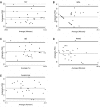Validity of Actigraphy in Measurement of Sleep in Young Adults With Type 1 Diabetes
- PMID: 28162146
- PMCID: PMC5406945
- DOI: 10.5664/jcsm.6580
Validity of Actigraphy in Measurement of Sleep in Young Adults With Type 1 Diabetes
Abstract
Study objectives: Accurate objective measurement of sleep, an important health behavior, is needed. Individuals with type 1 diabetes mellitus (T1DM) have altered sleep architecture and reduced sleep quality in comparison with healthy controls. The aim of this investigation was to compare a commonly used actigraphy device, Actiwatch2, with polysomnography (PSG)-based measures of sleep in young adults with T1DM, and to determine which Actiwatch2 threshold setting provides the best correspondence.
Methods: Subjects age 18-30 years with T1DM wore the Actiwatch2 while simultaneously undergoing in-laboratory PSG. Sleep parameters were derived from the Actiwatch2 using the three different sensitivity thresholds (low, medium, and high) provided by the manufacturer and compared with sleep parameters from PSG. Statistical analysis included intraclass correlation coefficients and Bland-Altman plots for comparison of sleep parameters. Cohen kappa and the prevalence-adjusted and bias-adjusted kappa (PABAK) were calculated to determine agreement between epoch-by-epoch sleep and wake data measured by the PSG versus Actiwatch2.
Results: Twenty-seven subjects were included in the analysis. The low threshold setting provided the greatest agreement and least bias in comparison with PSG for sleep parameters (intraclass correlation coefficient range 0.38 to 0.77). Mean differences between the low setting and PSG were nonsignificant (P > .65) for all sleep parameters except sleep onset latency (P = .04). All three settings provided approximately equivalent and moderate epoch-by-epoch agreement with the PSG (PABAK coefficients ranging from 0.56 to 0.63).
Conclusions: When measuring sleep with the Actiwatch2 in young adults with T1DM, the low threshold setting provides the most accurate estimates of sleep parameters in comparison with PSG.
Keywords: actigraphy; sleep; type 1 diabetes; validation.
© 2017 American Academy of Sleep Medicine
Figures

Similar articles
-
Agreement between actigraphic and polysomnographic measures of sleep in adults with and without chronic conditions: A systematic review and meta-analysis.Sleep Med Rev. 2019 Aug;46:151-160. doi: 10.1016/j.smrv.2019.05.001. Epub 2019 May 13. Sleep Med Rev. 2019. PMID: 31154154 Free PMC article.
-
Comparison of Commercial Wrist-Based and Smartphone Accelerometers, Actigraphy, and PSG in a Clinical Cohort of Children and Adolescents.J Clin Sleep Med. 2016 Mar;12(3):343-50. doi: 10.5664/jcsm.5580. J Clin Sleep Med. 2016. PMID: 26446248 Free PMC article.
-
Direct comparison of two actigraphy devices with polysomnographically recorded naps in healthy young adults.Chronobiol Int. 2013 Jun;30(5):691-8. doi: 10.3109/07420528.2013.782312. Epub 2013 May 30. Chronobiol Int. 2013. PMID: 23721120
-
Improving Sleep Quality Assessment Using Wearable Sensors by Including Information From Postural/Sleep Position Changes and Body Acceleration: A Comparison of Chest-Worn Sensors, Wrist Actigraphy, and Polysomnography.J Clin Sleep Med. 2017 Nov 15;13(11):1301-1310. doi: 10.5664/jcsm.6802. J Clin Sleep Med. 2017. PMID: 28992827 Free PMC article.
-
Monitoring healthy and disturbed sleep through smartphone applications: a review of experimental evidence.Sleep Breath. 2019 Mar;23(1):13-24. doi: 10.1007/s11325-018-1661-3. Epub 2018 Apr 23. Sleep Breath. 2019. PMID: 29687190 Review.
Cited by
-
Agreement between actigraphic and polysomnographic measures of sleep in adults with and without chronic conditions: A systematic review and meta-analysis.Sleep Med Rev. 2019 Aug;46:151-160. doi: 10.1016/j.smrv.2019.05.001. Epub 2019 May 13. Sleep Med Rev. 2019. PMID: 31154154 Free PMC article.
-
A Randomized Pilot Cognitive Behavioral Sleep Health Trial for Young Adults with Type 1 Diabetes.Behav Sleep Med. 2025 Jun 26:1-13. doi: 10.1080/15402002.2025.2522680. Online ahead of print. Behav Sleep Med. 2025. PMID: 40571674
-
Performance of a commercial multi-sensor wearable (Fitbit Charge HR) in measuring physical activity and sleep in healthy children.PLoS One. 2020 Sep 4;15(9):e0237719. doi: 10.1371/journal.pone.0237719. eCollection 2020. PLoS One. 2020. PMID: 32886714 Free PMC article.
-
Sleep-wake characteristics, daytime sleepiness, and glycemia in young adults with type 1 diabetes.J Clin Sleep Med. 2021 Sep 1;17(9):1865-1874. doi: 10.5664/jcsm.9402. J Clin Sleep Med. 2021. PMID: 33949941 Free PMC article.
-
Sleep characteristics in young adults with type 1 diabetes.Diabetes Res Clin Pract. 2019 Apr;150:17-26. doi: 10.1016/j.diabres.2019.02.012. Epub 2019 Feb 18. Diabetes Res Clin Pract. 2019. PMID: 30790611 Free PMC article. Review.
References
-
- Cellini N, Buman MP, McDevitt EA, Ricker AA, Mednick SC. Direct comparison of two actigraphy devices with polysomnographically recorded naps in healthy young adults. Chronobiol Int. 2013;30(5):691–698. - PubMed
-
- Kanady JC, Drummond SPA, Mednick SC. Actigraphic assessment of a polysomnographic-recorded nap: a validation study. J Sleep Res. 2011;20(1 Pt 2):214–222. - PubMed
-
- Lichstein KL, Stone KC, Donaldson J, et al. Actigraphy validation with insomnia. Sleep. 2006;29(2):232–239. - PubMed
MeSH terms
LinkOut - more resources
Full Text Sources
Other Literature Sources
Medical

